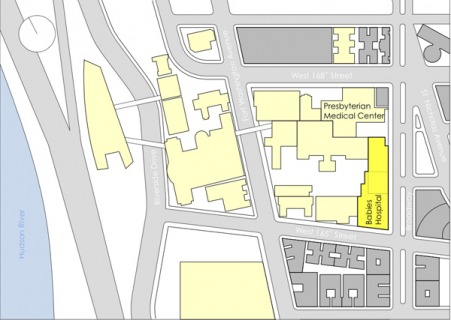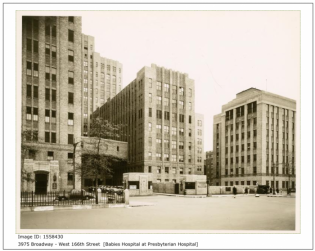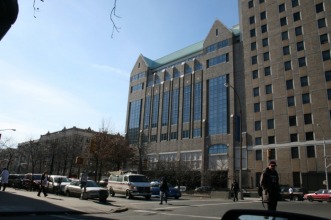Babies Hospital

Babies Hospital is New York’s oldest hospital dedicated to the care of children and infants. Situated in a diverse northern Manhattan neighborhood, in close proximity to the Bronx, Westchester County, and New Jersey, the hospital has thrived both as an essential community institution, as well as a critical element in the pediatric healthcare landscape at the regional level and beyond.
The hospital was founded in the 1890s as a private hospital for sick infants on Lexington Avenue and 55th Street. In 1928 the hospital moved into a new building at complex it shared with the Columbia University Medical Center. The new site was bounded by Broadway on the east, Fort Washington Avenue on the west, West 168th Street on the north, and West 165th Street on the south. The two closest neighboring institutions were the Deaf and Dumb Asylum, on West165th Street and Riverside Drive, and the 22nd Regiment Armory between West 168th Street and West 169th Street. The new hospital site had previous relevance to children as American League Park, also known as Hilltop Park, which was home to the New York Highlanders baseball team from 1903 until 1913. The Highlanders eventually moved to the Bronx and were renamed the Yankees. Today a bronzed home plate in the courtyard at the center of the complex marks the location of home base at the old ballpark.
Upon completion the new Babies Hospital building was celebrated as a progressive, state of the art, facility. Diana Rice of The New York Times touted the facility as “the last word in hospital design and equipment.” The twelve-story building was designed to accommodate a variety of programs related to children’s healthcare, including private and shared patient rooms, a nurse’s training center, a nurse dormitory, classrooms for medical students, playrooms, solariums, a roof garden, and paneled administrative facilities. A collection of WPA photographs of the hospital from the 1930s shows nurses and patients on one of the hospital’s roof gardens stacking toy wooden crates and playing in a sandbox.
The hospital was founded in the 1890s as a private hospital for sick infants on Lexington Avenue and 55th Street. In 1928 the hospital moved into a new building at complex it shared with the Columbia University Medical Center. The new site was bounded by Broadway on the east, Fort Washington Avenue on the west, West 168th Street on the north, and West 165th Street on the south. The two closest neighboring institutions were the Deaf and Dumb Asylum, on West165th Street and Riverside Drive, and the 22nd Regiment Armory between West 168th Street and West 169th Street. The new hospital site had previous relevance to children as American League Park, also known as Hilltop Park, which was home to the New York Highlanders baseball team from 1903 until 1913. The Highlanders eventually moved to the Bronx and were renamed the Yankees. Today a bronzed home plate in the courtyard at the center of the complex marks the location of home base at the old ballpark.
Upon completion the new Babies Hospital building was celebrated as a progressive, state of the art, facility. Diana Rice of The New York Times touted the facility as “the last word in hospital design and equipment.” The twelve-story building was designed to accommodate a variety of programs related to children’s healthcare, including private and shared patient rooms, a nurse’s training center, a nurse dormitory, classrooms for medical students, playrooms, solariums, a roof garden, and paneled administrative facilities. A collection of WPA photographs of the hospital from the 1930s shows nurses and patients on one of the hospital’s roof gardens stacking toy wooden crates and playing in a sandbox.

The hospital was as progressive socially as it was in its approach to its physical plant. Children of all racial and socioeconomic backgrounds were cared for in the same place. Of course more affluent families could pay for private rooms, but there were still shared facilities for all including playrooms. This dedication to diversity and acceptance was a result of hospital policy when it opened. Today the hospital continues to serve a diverse population, though its current diversity is more a factor of its diverse neighborhood rather then hospital policy.
Babies’ evolution was typical of children hospitals all over the country. However, rather then being a trendsetter as Diana Rice suggested, the hospital seems to have met institutional milestones a tad later then its contemporaries. While the hospital was innovative for New York, in reality it was learning from the moves of other children’s hospitals in the United States. David Sloane identifies the period of about 1855-1890 as a time when children’s hospitals, founded largely by reform-minded women, emerged as a distinct new model for pediatric care. Babies, founded in the early 1890s, emerged at the tail end of this formative period.
In the early 20th century, progressive hospital reformers and architects began to grapple with the challenge of designing new facilities for children’s hospitals that could combine the efficiency and technology of general hospitals with the homey environment of children’s hospitals. Sloane described one such new progressive facility, Sara Morris Children’s Hospital in Chicago, built in 1913. Among the new amenities the hospital included a playroom, and a milk station, along side the modern surgical suite. These elements were also central in the design of Babies Hospital. Once again Babies was not inventing these new ideas, but simply bringing them to New York. Though it is notable that in 1902, Babies replaced its original home in a Lexington Avenue Brownstone with a custom designed eight-story building, which was among the earliest buildings to be designed specifically as a children’s hospital.
Babies’ evolution was typical of children hospitals all over the country. However, rather then being a trendsetter as Diana Rice suggested, the hospital seems to have met institutional milestones a tad later then its contemporaries. While the hospital was innovative for New York, in reality it was learning from the moves of other children’s hospitals in the United States. David Sloane identifies the period of about 1855-1890 as a time when children’s hospitals, founded largely by reform-minded women, emerged as a distinct new model for pediatric care. Babies, founded in the early 1890s, emerged at the tail end of this formative period.
In the early 20th century, progressive hospital reformers and architects began to grapple with the challenge of designing new facilities for children’s hospitals that could combine the efficiency and technology of general hospitals with the homey environment of children’s hospitals. Sloane described one such new progressive facility, Sara Morris Children’s Hospital in Chicago, built in 1913. Among the new amenities the hospital included a playroom, and a milk station, along side the modern surgical suite. These elements were also central in the design of Babies Hospital. Once again Babies was not inventing these new ideas, but simply bringing them to New York. Though it is notable that in 1902, Babies replaced its original home in a Lexington Avenue Brownstone with a custom designed eight-story building, which was among the earliest buildings to be designed specifically as a children’s hospital.

Babies has evolved significantly over the past century. The building has been renovated countless times, and the spaces have changed as programs have become outdated and new standards of care have necessitated new accommodations. During World War Two, the hospital announced plans to expand. Theseplans were evidently realized with a major capital improvement plan implemented in the early 1960s. Babies South was erected immediately adjacent to the older building and separated by a parti wall, opened in the early 1970s nearly doubling the size of the hospital.
Smaller changes have continued to bring the hospital in line with contemporary attitudes towards both medicine and children. In thelate 1990s a renovation to the pediatric intensive care unit (PICU), described in Interior Design, the architect expressed a variety of concerns including creating spaces that accommodated parents (an un-thought-of idea even for the progressives who designed the original hospital). The decoration in the renovation made use of bright colors and oversized fantasy-themed graphics.
The PICU renovation, sponsored by Morgan Stanley, was followed up by a much larger addition to the hospital, also sponsored and named after the financial firm. The Morgan Stanley Children’s Hospital of New York opened in the fall of 2003, largely in response to the growing need for more beds. The new building rose above a former parking lot on the north-westcorner of West 165th Streetand Broadwayand is adjacent to the older buildings. The opening of the Morgan Stanley building elicited similar reactions to the 1929 opening. It has been celebrated as a means of hiding the institutional character that makes hospitals so uninviting especially for young patients. As in the PICU addition the new hospital is full of colorful graphics, spatial accommodations are made for parents, and an open plan is employed where possible to avoid the labyrinthine confusion so common in hospitals. A major difference between the Morgan Stanley opening, and the opening of 1928, is that Babies now exists along side several other hospitals for children in the New York metropolitan area. With in three years of Morgan Stanley’s opening, new facilities for children’s hospitals opened at New York Medical Center in Westchester County, and Montefiore Medical Center in the Bronx.
What distinguishes Babies from these other institutions is the hospital’s long history of serving sick children in New York. The hospital has continued to operate according to a consistent mission, while adapting to changing and diversifying attitudes towards both medicine and children, and in a changing and diversifying neighborhood.
Smaller changes have continued to bring the hospital in line with contemporary attitudes towards both medicine and children. In thelate 1990s a renovation to the pediatric intensive care unit (PICU), described in Interior Design, the architect expressed a variety of concerns including creating spaces that accommodated parents (an un-thought-of idea even for the progressives who designed the original hospital). The decoration in the renovation made use of bright colors and oversized fantasy-themed graphics.
The PICU renovation, sponsored by Morgan Stanley, was followed up by a much larger addition to the hospital, also sponsored and named after the financial firm. The Morgan Stanley Children’s Hospital of New York opened in the fall of 2003, largely in response to the growing need for more beds. The new building rose above a former parking lot on the north-westcorner of West 165th Streetand Broadwayand is adjacent to the older buildings. The opening of the Morgan Stanley building elicited similar reactions to the 1929 opening. It has been celebrated as a means of hiding the institutional character that makes hospitals so uninviting especially for young patients. As in the PICU addition the new hospital is full of colorful graphics, spatial accommodations are made for parents, and an open plan is employed where possible to avoid the labyrinthine confusion so common in hospitals. A major difference between the Morgan Stanley opening, and the opening of 1928, is that Babies now exists along side several other hospitals for children in the New York metropolitan area. With in three years of Morgan Stanley’s opening, new facilities for children’s hospitals opened at New York Medical Center in Westchester County, and Montefiore Medical Center in the Bronx.
What distinguishes Babies from these other institutions is the hospital’s long history of serving sick children in New York. The hospital has continued to operate according to a consistent mission, while adapting to changing and diversifying attitudes towards both medicine and children, and in a changing and diversifying neighborhood.
